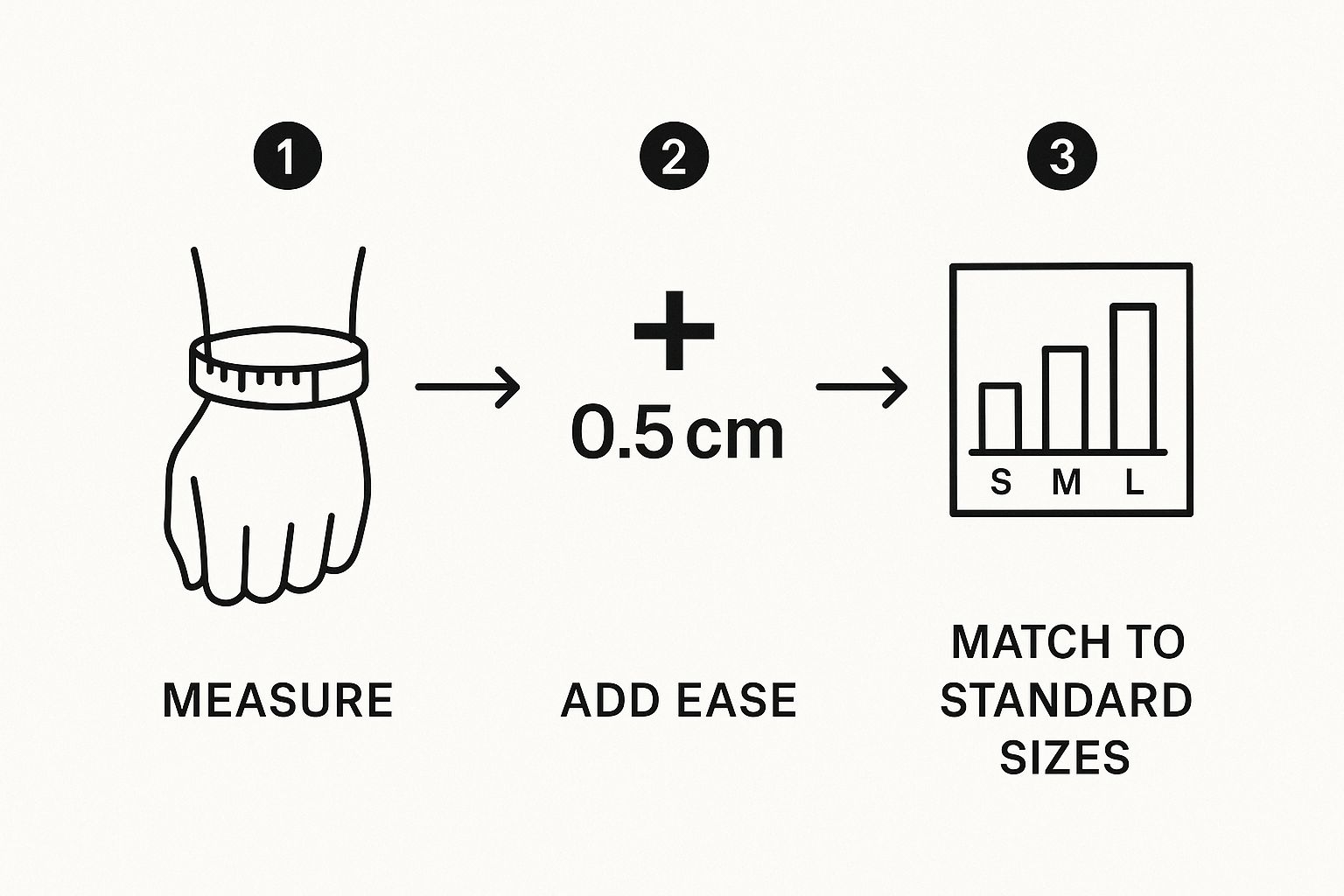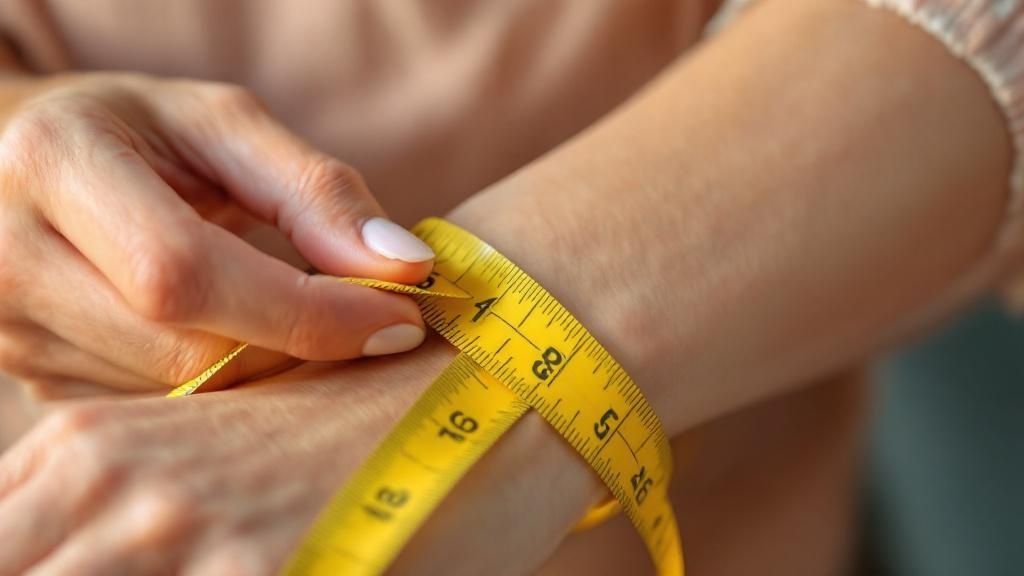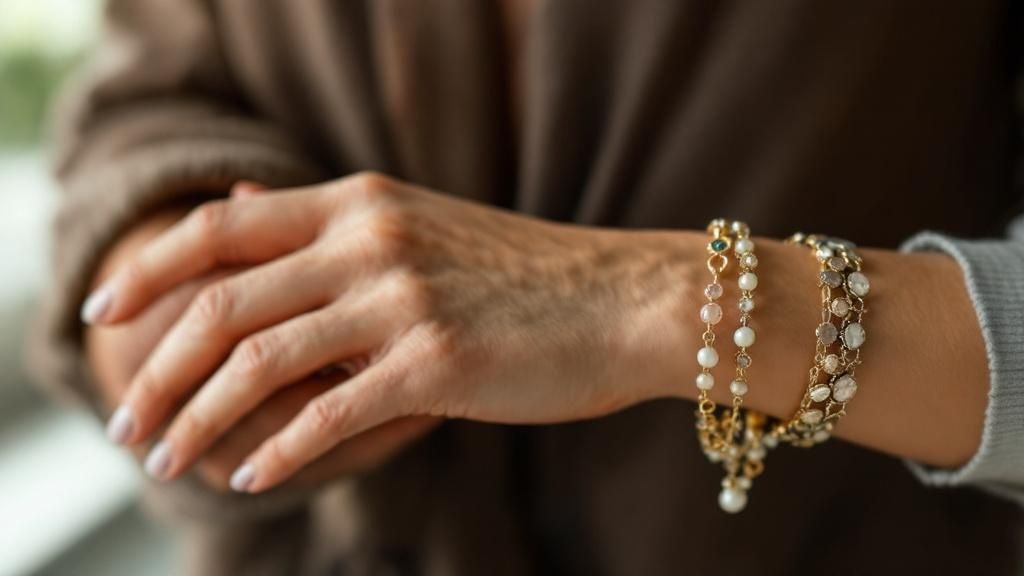Bracelet Size Chart Find Your Perfect Fit
- Luke Zucco
- Aug 12
- 11 min read
A bracelet size chart is your best friend when shopping for jewelry. It's a simple tool that helps you convert your wrist measurement into the perfect bracelet length, usually by adding 0.5 to 1.25 inches for a comfortable fit. This little bit of extra room is the secret to getting a bracelet that drapes beautifully without feeling too tight or risking slipping off.
Getting the right fit is all about bridging the gap between your measurement and the final size that suits your style.
Your Instant Bracelet Size Guide
Buying a bracelet online can feel like guesswork, but it doesn't have to be. Figuring out your perfect size is surprisingly easy and takes just a minute. You don't even need any fancy tools—a simple piece of string and a ruler are all it takes to get an accurate wrist measurement.
But here’s the most important thing to remember: your wrist measurement is not your bracelet size. The magic happens when you add a little extra length, what we call a "comfort gap." This ensures the bracelet can move and breathe on your wrist. How much space you add really comes down to personal taste and the style of the bracelet.
Find Your Fit Instantly
Once you've got that measurement, a size chart becomes your go-to guide. For delicate, barely-there chains, you'll want a snugger fit. For chunkier bangles or charm bracelets that need room to jingle, a looser fit is the way to go.
The most common mistake people make is choosing a bracelet that matches their exact wrist size. Always add a little extra for comfort and movement. It's what separates a bracelet you like from one you'll love and wear constantly.
This small adjustment truly makes all the difference. Here’s a quick-reference chart to help you find the perfect bracelet size for any style you have in mind.
Quick Bracelet Size Finder
Use your wrist measurement below to find the recommended bracelet size based on how you want it to fit.
Wrist Measurement (Inches/CM) | Snug Fit (Delicate Chains) | Comfort Fit (Standard Styles) | Loose Fit (Charms/Cuffs) |
|---|---|---|---|
6 in / 15.2 cm | 6.5 in / 16.5 cm | 7 in / 17.8 cm | 7.25 in / 18.4 cm |
6.5 in / 16.5 cm | 7 in / 17.8 cm | 7.5 in / 19 cm | 7.75 in / 19.7 cm |
7 in / 17.8 cm | 7.5 in / 19 cm | 8 in / 20.3 cm | 8.25 in / 21 cm |
7.5 in / 19 cm | 8 in / 20.3 cm | 8.5 in / 21.6 cm | 8.75 in / 22.2 cm |
8 in / 20.3 cm | 8.5 in / 21.6 cm | 9 in / 22.9 cm | 9.25 in / 23.5 cm |
Think of this table as your starting point. It takes the guesswork out of sizing and helps you zero in on the length that will feel just right on your wrist.
How to Measure Your Wrist The Right Way
Finding a bracelet that feels like it was made for you all comes down to one thing: an accurate wrist measurement. Think of it as laying the foundation for a house—if it's even a little bit off, the whole structure will feel wrong. The goal here is to get the exact circumference of your wrist so you can confidently use a size chart.
Don't worry, you won't need any fancy tools. There are two incredibly simple and reliable ways to do this right at home.
The Two Best Measurement Methods
1. The Flexible Measuring Tape Method: This is the most straightforward way to get your size. Grab a flexible tailor's tape and wrap it around your wrist, right where your bracelet will sit. For most people, that's just below the wrist bone.
The key is to make it snug but not tight. You shouldn't be squeezing your wrist at all. Once it's comfortably in place, just read the number where the end of the tape meets the zero mark. That's your wrist measurement.
2. The String and Ruler Method: If you don't have a flexible tape measure, no problem. A piece of string or a thin strip of paper works just as well. Just make sure whatever you use doesn't stretch.
Wrap the string around your wrist, and use a pen to mark the spot where the end overlaps. Then, lay the string flat against a standard ruler to get the measurement. Easy.
This visual guide quickly shows you how to measure, add a bit for comfort, and find your perfect size.

Ultimately, your ideal bracelet size isn't just your wrist measurement—it’s that measurement plus a little breathing room.
Adding the Perfect Comfort Gap
Your raw measurement is just the starting point. The real secret to a bracelet that feels amazing is adding a "comfort gap." This extra length gives the bracelet room to move and drape naturally. How much you add is totally up to you and the type of bracelet you're buying.
Remember, the goal isn't to see how tightly you can pull the tape. It's about getting a true, honest measurement of your wrist. A good base measurement is what makes the difference between a bracelet that just fits and one that feels perfect.
Here’s a simple guide to adding that extra space:
For a snug fit: Add 0.5 inches (1.25 cm). This is great for delicate chains that you want to sit close to the skin.
For a standard, comfortable fit: Add 1 inch (2.5 cm). This is the sweet spot for most everyday bracelets, giving them just enough movement.
For a loose fit: Add 1.25 inches (3.2 cm). This is ideal for chunky styles or charm bracelets that need more room to jingle and move around.
Making Sense of a Standard Bracelet Size Chart

Alright, you've got your wrist measurement. Now what? This is where a bracelet size chart becomes your best friend. Think of it as a universal translator, taking your personal measurement in inches or centimeters and converting it into the sizes you see on product pages—"Small," "Medium," "Large." It’s what turns online jewelry shopping from a guessing game into a confident purchase.
It's really no different than buying a t-shirt. You have a good idea if you're a small or a large, and the same logic applies here. Jewelers use these standard sizes to create beautiful pieces that fit a wide range of people, making it much simpler for you to find something that fits just right without commissioning a custom design.
The size chart is simply the bridge between your unique wrist size and the huge world of ready-to-wear bracelets. It creates a common language for shoppers and sellers, which means less confusion and more confidence when you buy.
For instance, a woman's "Medium" bracelet is typically 7 inches long. This size is specifically designed to fit someone whose wrist measures around 6 inches, leaving just enough room for comfort and movement. That little bit of extra space is the secret to a great fit.
The Universal Bracelet Size Chart
Getting familiar with these universal sizes is the key to success. While you might find slight variations from one brand to another, most jewelers stick to a pretty consistent framework. This is crucial for a global market, where a reliable sizing system builds trust.
Here’s a quick look at how your wrist measurement typically translates into a standard size for women, men, and children:
Women's Sizing: A 6-inch wrist usually takes a "Small" (6.5-inch) bracelet. If your wrist is 7 inches, you'd likely wear a "Large" (7.5-inch) bracelet.
Men's Sizing: Men's sizes naturally start a bit larger. A 7.5-inch wrist often corresponds to a "Small" (8-inch) men's bracelet, while an 8.5-inch wrist would need a "Large" (9-inch) bracelet.
Children's Sizing: This can vary quite a bit depending on age, but a common "Medium" for a child often falls around the 6-inch mark.
This kind of standardization is what allows the industry to thrive. In fact, the global bracelet market was valued at around $2.42 billion and is expected to hit $3.61 billion by 2032. That growth shows just how important it is to have accessible sizing for all kinds of customers.
Of course, this focus on getting the right fit isn't limited to bracelets. Knowing how to measure properly is just as vital for other types of jewelry. If you’re curious about sizing beyond the wrist, you might find our guide on how to resize a ring at home safely helpful, too.
Sizing Secrets for Different Bracelet Styles
Not all bracelets are created equal. A size 7 on a delicate chain will feel completely different from a size 7 bangle, and assuming one size fits all styles is a classic recipe for a poor fit. Each bracelet type sits on your wrist in its own unique way, so learning their individual sizing quirks is the key to a perfect fit every time.
A bracelet's design—whether it’s flexible, rigid, or meant to carry charms—is what really determines how much extra room you'll need. This is why a standard bracelet size chart is just a starting point. The real magic happens when you adjust your measurements for the specific style you're buying.
Think of it like this: you wouldn't use the same recipe for a light, airy sponge cake and a dense, heavy fruitcake. The core ingredients might look similar, but the structure demands a totally different approach. Bracelets are no different.
Matching the Fit to the Form
Chain and Link BraceletsThese are the most common and generally the most forgiving. Their flexible design drapes naturally over the wrist, so the standard "comfort fit" rule works beautifully here. Just add about one inch to your actual wrist measurement, and you should be good to go.
Charm BraceletsHere’s where you need to think ahead. Charm bracelets need extra space because as you add charms, the internal circumference gets tighter. To prevent your bracelet from becoming stiff and crowded down the line, plan for growth. Start by adding 1.25 inches to your wrist size to ensure it hangs gracefully as your collection expands.
The single most common sizing mistake happens with bangles. People measure their wrist, but a bangle has to fit over your hand. A perfect wrist measurement is useless if the bangle can't get past your knuckles.
Bangle BraceletsSince these are solid, rigid circles without a clasp, the measurement is all about getting it on and off. The trick is to measure your hand, not your wrist. Tuck your thumb into your palm, just like you would when sliding on a bangle. Now, take a flexible measuring tape and wrap it around the widest part of your hand, which is usually across your knuckles. That measurement is your true bangle size.
Cuff BraceletsCuffs are a bit different because they have an opening, allowing you to slip them on sideways over the narrowest part of your wrist. For these, you’ll want a size that’s very close to your actual wrist measurement. While most are slightly adjustable, you want a snug fit that keeps the cuff from spinning or falling off. Avoid repeatedly bending the metal to get it on and off, as this can weaken and eventually break it. Getting the size right from the start is crucial.
Sizing for Luxury and Custom Bracelets

When you’re investing in a luxury or custom-made bracelet, "close enough" just doesn't cut it. In the world of high-end jewelry, where artisans craft pieces from precious metals and brilliant gemstones, the fit is every bit as crucial as the design itself. That’s why you’ll find that luxury brands either provide incredibly detailed sizing options or offer bespoke services to get it just right.
Think of it as protecting your investment while ensuring the piece is a genuine pleasure to wear. A poorly fitted luxury bracelet isn’t just uncomfortable; it’s far more likely to get snagged, damaged, or worse, lost. The demand for perfectly personalized jewelry has pushed the high-end market to treat sizing with absolute precision, which is why your accurate wrist measurement is the most important first step you can take.
Precision as a Priority
The growing appetite for high-end accessories only amplifies the need for a perfect fit. The luxury bracelets market, currently valued at around USD 7.8 billion, is expected to soar to USD 13.1 billion by 2033. This surge is fueled by discerning customers who demand a flawless experience from the moment they choose a design to the second it fastens around their wrist. You can read more about these insights into the luxury bracelet market here.
When dealing with valuable materials, a precise bracelet size chart isn't just a guide—it’s a guarantee. It ensures the piece feels like it was truly made for you, blending security with comfort.
This focus on detail doesn't stop with the fit; it's also about preserving the piece for years to come. Maintaining the pristine condition of such a valuable item is essential. For tips on keeping your pieces sparkling, you might find our guide on how to clean silver jewelry at home with easy tricks helpful. With luxury items, every detail matters, and it all starts with the perfect fit.
How Smart Bracelets Changed Sizing Forever

When wearable tech hit the scene, the right fit suddenly became about a lot more than just looking good—it became about function. The arrival of smart bracelets and fitness trackers has completely changed how we approach sizing. For these high-tech gadgets, a perfect fit isn't just nice to have; it’s essential for making sure their health-tracking sensors actually work.
Think about it: a smart bracelet that’s too loose will slide around, causing the heart rate monitor to give you wonky readings or the step counter to completely miss your morning walk. This need for precision has forced tech companies to get really creative with their sizing, pushing far beyond the old "small, medium, large" model we're all used to.
The golden rule for smart bracelet sizing is simple: the device needs to stay in constant contact with your skin, but without feeling uncomfortably tight. It's a delicate balance that ensures the advanced sensors work as intended while you can almost forget you're even wearing it.
This has led to a whole new world of sizing solutions. We now have infinitely adjustable sport loops made from hook-and-loop fabric and custom-molded bands like the Solo Loop, which you have to measure your wrist for before you can even click "buy." This innovation isn't just for show; a device's entire value is tied to how well it performs.
A New Standard in Sizing
With the global smart bracelet market valued at around USD 34.5 billion and climbing, getting the fit right is big business. Given the enormous diversity in wrist sizes across the globe, adjustable and precisely sized bands are crucial for any brand that wants to succeed. You can learn more about the growth of the smart bracelet market and see just how much this influences product design.
What's really interesting is how this tech-driven push for a perfect fit is starting to ripple out into the traditional jewelry world. People are getting used to bracelets that feel like they were made just for them, and now they're starting to expect that same level of comfort and personalization from classic jewelry makers. It’s encouraging a new wave of innovative designs for every kind of wrist.
Have More Questions About Bracelet Sizing? Let's Clear Them Up
Getting your measurement right is half the battle, but even with a perfect size chart, some questions always come to mind. If you're still wondering about a few details, you're not alone. Let's tackle some of the most common questions to help you find that perfect fit with confidence.
What’s the Average Bracelet Size for a Woman?
If you look at the numbers, the most common bracelet size for women lands somewhere between 7 and 7.5 inches. But here’s a word of caution from experience: relying on an "average" can be a gamble. Everyone's body is unique, so what's average for the market might not be what's comfortable for you. Always, always measure your own wrist first.
Should a Bracelet Be Tight or Loose?
Honestly, this comes down to two things: the style of the bracelet and what feels good to you. A good rule of thumb for most bracelets is a "comfort fit"—snug enough that it won’t fall off, but with enough room to move a little on your wrist.
Think of it this way:
A charm bracelet needs a bit more slack to make room for all the charms, while a delicate chain often looks best worn closer to the skin.
For anyone who struggles with metal allergies, the material is just as crucial as the fit. If that sounds like you, Panther De Luxe offers some fantastic advice in their guide to jewelry for sensitive skin.

Comments